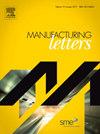表面洞察力:利用高密度数据集融合增强粗糙度分类能力
IF 1.9
Q3 ENGINEERING, MANUFACTURING
引用次数: 0
摘要
在制造系统中,快速准确地评估表面质量的能力极为重要。现代计量系统和机器学习在分类方面非常出色,但需要更多时间。传统上,获取表面粗糙度是一个耗时的过程。随着制造技术的进步,有必要改进质量控制方法,特别是在表面粗糙度分类方面,这对材料的性能有重大影响。本研究通过结合图像数据和点云数据创建综合模型,介绍了一种新的表面粗糙度分类方法。然后将该模型的性能与仅依赖图像数据的模型进行比较。本研究进行了综合分析,收集并分析了图像和点云数据。采用多线性主成分分析法(MPCA)和随机森林分类器来创建表面纹理分类模型。主要目标是展示融合数据模型与仅依赖图像的模型相比所提供的更高精度和更全面的理解。此外,该工作还提出了一种实用方法,用于离线开发这种增强型模型,并将其在线应用于实时生产环境,尤其侧重于仅使用图像数据。这一策略符合工业 4.0 的目标,即实现更加智能和数据驱动的生产流程。随后的研究将优先考虑扩大模型在各种生产环境中的适用性,特别是突出其通过利用图像确保生产线质量的能力。本文章由计算机程序翻译,如有差异,请以英文原文为准。
Surface insight: Leveraging high-density dataset fusion for enhanced roughness classification
The ability to assess the surface quality quickly and accurately is of immense importance in manufacturing system. Modern metrology system along with machine learning is great at classification but requires more time. Traditionally accessing surface roughness is a time-consuming process. The progress in manufacturing technology necessitates improved approaches for quality control, specifically in the categorization of surface roughness, which has a substantial impact on the performance of materials. This research study introduces a novel method for classifying surface roughness by combining image data and point cloud data to create a comprehensive model. It then compares the performance of this model with a model that just relies on image data. A comprehensive analysis is conducted in this study, where image and point cloud data is collected and analysed. Multilinear principal component analysis (MPCA) along with random forest classifier is employed to create a model that classifies the surface texture. The primary goal is to showcase the enhanced precision and comprehensive understanding offered by the fused data model compared to the model that solely relies on images.
Furthermore, the work presents a pragmatic approach for developing this enhanced model offline and applying it online in real-time production environments, with a particular focus on using only image data. This strategy is in line with the objectives of Industry 4.0, which seeks to achieve more intelligent and data-driven manufacturing processes. Subsequent investigations will prioritize expanding the model’s suitability to various manufacturing settings, particularly highlighting its capacity to ensure quality in manufacturing lines through the utilization of images.
求助全文
通过发布文献求助,成功后即可免费获取论文全文。
去求助
来源期刊

Manufacturing Letters
Engineering-Industrial and Manufacturing Engineering
CiteScore
4.20
自引率
5.10%
发文量
192
审稿时长
60 days
 求助内容:
求助内容: 应助结果提醒方式:
应助结果提醒方式:


